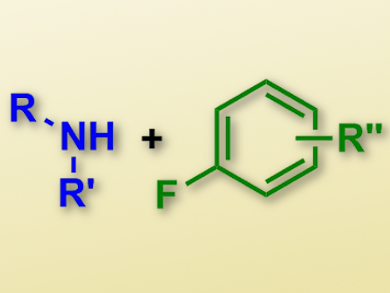Aniline derivatives synthesized via the N-arylation of amines have applications, e.g., as pharmaceuticals. However, the required halide-to-nitrogen substitution of aryl halides traditionally proceeds over transition-metal catalysts, which are expensive and sensitive. An alternative is the use of bases, which can be challenging depending on the substrate.
Frederik Diness and colleagues, University of Copenhagen, Denmark, have investigated the N-arylation of unactivated fluorobenzenes. They determined that a base is required to deprotonate the nitrogen and create a strong nucleophile, but must not act as a competing nucleophile itself. Additionally, in the case of very strong bases, the base may degrade the fluorobenzene electrophile, resulting in some non-selective side reactions.
The simple base Li-bis(trimethylsilyl)amide (LiHMDS) was able to deprotonate a broad range of amines, including alkyl-, aryl-, or alkoxy-substituted cyclic or acyclic amines, and promote their reaction with a range of fluorobenzenes with high regio- and chemoselectivity. It was found that the difficulty in promoting SNAr reactions on unactivated fluorobenzenes is in general not due to lack of reactivity, as previously thought, but simply an issue of avoiding competing side reactions. Among other compounds, the antidepressant Vortioxetine was synthesized in two steps from 1,2-difluorobenzene using this approach.
- Mechanism and Scope of Base-Controlled Catalyst-Free N-Arylation of Amines with Unactivated Fluorobenzenes,
Christian Borch Jacobsen, Morten Meldal, Frederik Diness,
Chem. Eur. J. 2016.
DOI: 10.1002/chem.201604098




